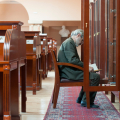MATENADARAN - INSTITUTE OF ANCIENT MANUSCRIPTS
Museum to discover the world's largest Armenian manuscript, as well as works on history, philosophy, medicine...
A highlight of any visit to Yerevan, this museum has been completely restored. The gray basalt building, built in 1957, still stands at the northern end of Mashtots Avenue, but since 2012 (the year Yerevan was designated "World Book Capital" by UNESCO, at the time of the 500th anniversary of the first book printed in Armenian in Venice), it is flanked by a new wing, whose architecture fits harmoniously into the décor. Every effort has been made to optimize and modernize the means of preserving this invaluable heritage of thousands of manuscripts stored here, and to acquire others as well, still scattered throughout the world. Some 20,000 ancient manuscripts, most of them donated, are carefully kept here; 17,000 of them are in Armenian, the others are in Persian, Greek, Arabic, etc., and the rest in Persian, Greek, Arabic, etc., and the rest are in Armenian. There are also archives and diplomatic documents from the fourteenth to the nineteenth century. A national treasure which is guarded at the entrance of the building by statues of Mesrop Machtots (361-440), the inventor of the alphabet, and great Armenian thinkers, scholars, philosophers and theologians. It was they - Anania of Shirak (7th c.), Gregory of Tatev (15th c.) and Moses of Khoren (5th c.) - who contributed to the spread of the book by opening their culture to the great Greek classics, whose manuscripts were collected in Armenia for translation when the national alphabet was created in 405. The Matenadaran ("library" in ancient Armenian) bears witness to the importance accorded to books in Armenian culture. " For the foolish, the manuscript has no value, for the wise, it has the price of the world," says the colophon (final note of a book) of one of these piously preserved books. The book, in which the Armenians gave the best of their pictorial art, in its rich illuminations, is a sacred object that had to be preserved at all costs, at the sacrifice of his life and his sight, as far as the medieval copyists who were damaged in transcribing sacred or learned texts are concerned, guided by this conviction expressed in several manuscripts: "This hand will become dust again, the written book will perpetuate its memory. "These precious manuscripts were kept partly in the library of the Catholicossate, but also in churches and monasteries throughout the country. Their preservation during the massacres of the Ottoman Empire in 1915 gave rise to acts of heroism, such as that of the two women who risked their lives to bring back the Homily of Mouch (Turkey), now in the Matenadaran (No. 7779). Of the 30,000 Armenian books existing in the world today, which were copied between the early Middle Ages and the 18th century, when the use of printing became widespread, 11,000 manuscripts, almost a third of which are illustrated, are preserved in their entirety in the Matenadaran, to which must be added 2,000 fragments, about 430 parchments, and the rest (over 3,000) consisting of European and Oriental medieval manuscripts. An enormous heritage that makes Armenia one of the richest countries in illuminated manuscripts. Born probably in the 5th century, the art of the miniature reached its apogee in Cilician Armenia in the 13th century. Its great master was Toros Roslin, who knew how to illuminate the pages of the Gospels and other manuscripts with expressive scenes and characters whose vivid colours have not been tarnished by time. In the Matenadaran, an armoured cellar is used to fight against the ravages of time; this fragile treasure, to which only duly licensed researchers have access, is kept in a microclimate, sheltered from dust and other aggressions. For it should not be forgotten that the Matenadaran is also an institute that attracts researchers and orientalists from all over the world. The oldest incunabulum is the Gospel of Lazarus (887), the earlier works having reached only fragmentary form. The first Armenian writings were translations, made by scholars who are still honoured today as the Holy Translators on the feast of Tarkmantchatz. Some of these writings have come down to us only in their Armenian version, such as the Chronicle of Eusebius of Caesarea or the treatise of philosophy On Nature by Zeno, the master of the Stoic school.
The rooms of the museum, on the first floor, contain enough treasures to dazzle the visitor: a succession of scholarly works on history, philosophy, mathematics and medicine, as well as the largest Armenian manuscript in the world (34 kg), which took 700 calf skins to make. This is in stark contrast to a 12-gram (3 x 4 cm) "miniature" manuscript in another display case. Gospel books from the 11th to the 15th century lead us into the wonderful world of book illumination, mixing gold with bright reds, and whose coating of metal and ornate gold sometimes makes the cover even more spectacular, as in the case of this 1255 Gospel set in a real case. There is also an ancient Assyrian manuscript or an Indian fan-shaped manuscript on palm leaves.
Did you know? This review was written by our professional authors.
Book the Best Activities with Get Your Guide
Members' reviews on MATENADARAN - INSTITUTE OF ANCIENT MANUSCRIPTS
The ratings and reviews below reflect the subjective opinions of members and not the opinion of The Little Witty.

